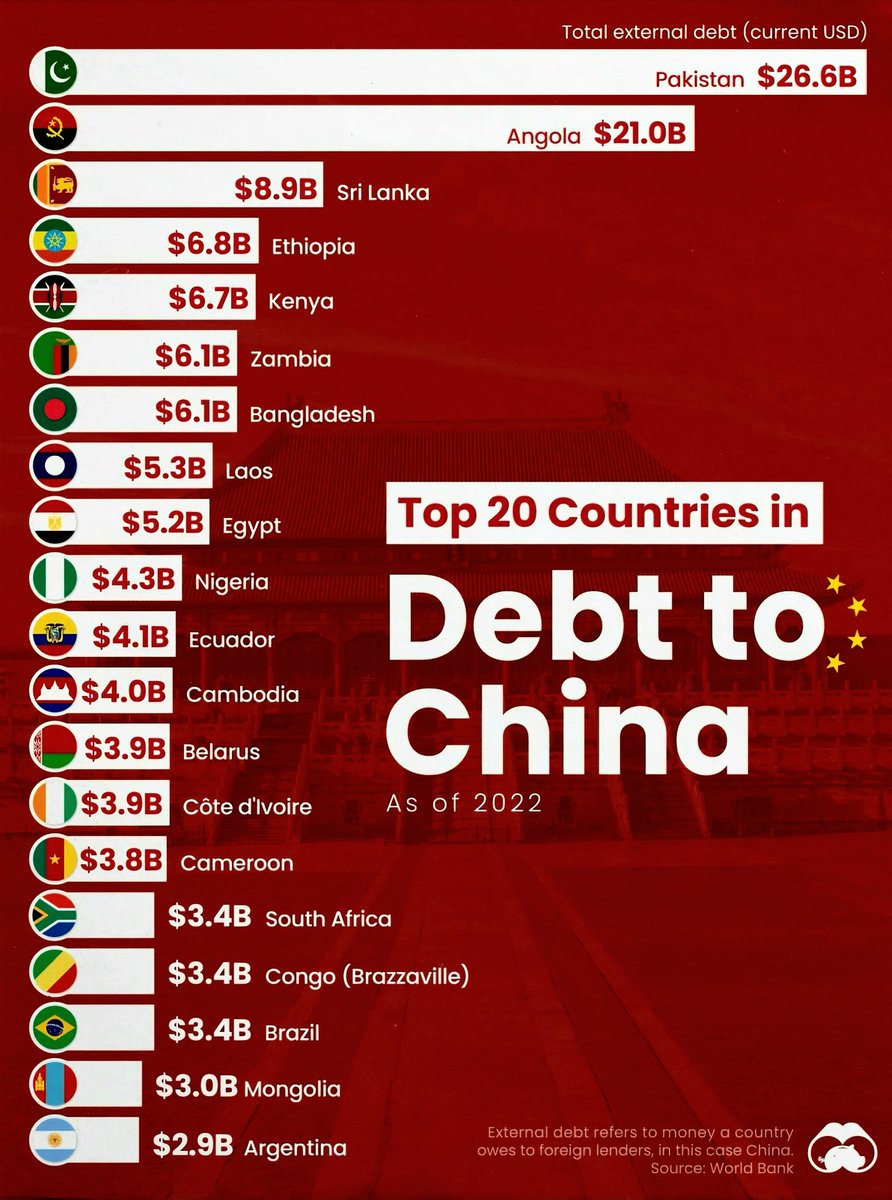Select Language:

1. Pakistan – $26.6 Billion
Pakistan remains the top debtor to China, with approximately $26.6 billion in outstanding loans. The debt primarily originates from large infrastructure projects under the Belt and Road Initiative (BRI). These projects aim to enhance connectivity and economic growth, but concerns about debt sustainability persist within Pakistan’s economic landscape.
2. Angola – $21 Billion
Angola holds the second spot with a debt of around $21 billion to China. Heavy investments from China in infrastructure, including roads, ports, and oil projects, have contributed significantly to this debt. The nation’s economy heavily relies on oil exports, and the debt levels raise discussions about future repayment capabilities amid fluctuating oil prices.
3. Sri Lanka – $8.9 Billion
Sri Lanka owes roughly $8.9 billion to China, much of which stems from the controversial Hambantota Port project. Critics argue that high debt levels threaten Sri Lanka’s economic stability, prompting concerns over asset loss, as the port was handed over to Chinese ownership temporarily due to repayment challenges.
4. Ethiopia – $6.8 Billion
Ethiopia has accumulated approximately $6.8 billion in debt to China. The country has benefited from Chinese investments across transportation, energy, and industrial parks. Despite rapid infrastructure development, the growing debt prompts ongoing debates about the country’s ability to manage repayments.
5. Kenya – $6.7 Billion
Kenya’s debt to China stands at about $6.7 billion, largely linked to railway projects like the Standard Gauge Railway connecting Nairobi to Mombasa. While these initiatives boost Kenya’s infrastructure and economic prospects, questions about long-term repayment obligations are evident.

6. Zambia – $6.1 Billion
With a debt of roughly $6.1 billion, Zambia faces challenges in managing its Chinese loans. The debt is primarily linked to mining and energy projects. Given Zambia’s reliance on copper exports, the economic strain could intensify if global commodity prices decline.
7. Bangladesh – $6.1 Billion
Bangladesh has accumulated around $6.1 billion in debts owed to China, with recent infrastructure projects including roads, bridges, and special economic zones. These investments are crucial for Bangladesh’s development, though some critics express concern about future debt repayments.
8. Laos – $5.3 Billion
Laos, a smaller country with a debt of about $5.3 billion to China, heavily depends on Chinese funds for infrastructure, including dams, roads, and hydropower plants. The rising debt raises questions about Laos’s economic sustainability and financial independence.
9. Egypt – $5.2 Billion
Egypt’s Chinese debt total is approximately $5.2 billion. Major projects include the development of the Suez Canal area and energy infrastructure. These projects align with Egypt’s strategic goal of becoming a regional hub, although debt servicing will pose ongoing economic considerations.
10. Nigeria – $4.3 Billion
Nigeria owes roughly $4.3 billion to China, mainly from infrastructure, energy, and transportation projects. As Africa’s largest economy, Nigeria’s debt to China emphasizes the continent’s increasing dependence on Chinese investment for growth and development.
11. Ecuador – $4.1 Billion
Ecuador holds nearly $4.1 billion in debt to China, much of which was arranged through oil-for-loans deals. While these agreements support Ecuador’s economic needs, they also contribute to balancing national debt and sustainability concerns.
12. Cambodia – $4.0 Billion
Cambodia’s debt to China is around $4 billion, mainly from infrastructure and development projects, including roads and power plants. The country’s strategic positioning in Southeast Asia makes Chinese investments both vital and scrutinized.
13. Belarus – $3.9 Billion
Belarus owes approximately $3.9 billion to China, primarily related to industrial modernization and infrastructure projects. The relationship strengthens Belarus-China economic cooperation, but long-term repayment strategies are under review.
14. Côte d’Ivoire – $3.9 Billion
With a debt of $3.9 billion, Côte d’Ivoire benefits from Chinese-funded infrastructure, including roads, ports, and energy projects. The debt raises important questions about economic resilience and debt management.
15. Cameroon – $3.8 Billion
Cameroon has accumulated debt totaling $3.8 billion to China. Large-scale projects such as railways and hydroelectric plants are central to this debt, with strategic economic impacts under close monitoring by policymakers.
16. South Africa – $3.4 Billion
South Africa’s debt to China is approximately $3.4 billion, covering mining, energy, and infrastructure ventures. Given South Africa’s economic challenges, the debt’s future implications are actively debated.
17. Republic of Congo (Brazzaville) – $3.4 Billion
The Republic of Congo owes roughly $3.4 billion to China. Major investments include transportation and energy infrastructure. As with other debtors, sustainability and repayment capacity are critical discussion points.
18. Brazil – $3.4 Billion
Brazil’s debt to China, totaling around $3.4 billion, focuses on infrastructure and energy projects. The economic impact of these investments remains significant amid evolving trade relations and domestic needs.
19. Mongolia – $3.0 Billion
Mongolia’s Chinese debt nears $3 billion, primarily from mining, energy, and infrastructure projects. Mongolia faces ongoing balancing acts to manage debt while seeking to diversify its economic partnerships.
20. Argentina – $2.9 Billion
Argentina owes close to $2.9 billion to China, mainly through infrastructure loans meant to bolster its economic recovery. Debt management remains a priority as Argentina navigates ongoing economic pressures.
As of 2025, China’s global lending landscape continues to evolve, with debt levels across various nations prompting renewed focus on economic sustainability and geopolitical influence.
Source: World Bank, 2025







